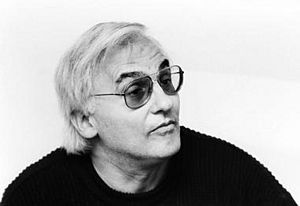Paul Bley facts for kids
Quick facts for kids
Paul Bley
|
|
|---|---|
 |
|
| Background information | |
| Birth name | Hyman Paul Bley |
| Born | November 10, 1932 Montreal, Quebec, Canada |
| Died | January 3, 2016 (aged 83) Stuart, Florida, U.S. |
| Genres | Avant-garde jazz, free jazz, free improvisation, post bop |
| Occupation(s) | Musician, composer |
| Instruments | Piano, synthesizers |
| Associated acts | Carla Bley, Art Blakey, Charlie Parker, Ben Webster, Sonny Rollins, Chet Baker, Don Cherry, Ornette Coleman, Gary Peacock, Jimmy Giuffre, Charlie Haden, Charles Mingus, Paul Motian, Annette Peacock, Gary Peacock, Sonny Rollins, Steve Swallow, Barry Altschul, Jaco Pastorius, Pat Metheny, John Abercrombie, Coleman Hawkins, Steve Lacy |
Paul Bley (November 10, 1932 – January 3, 2016) was a famous jazz pianist. He was known for his important role in the free jazz movement of the 1960s. Paul Bley also brought new ideas to how jazz trios played. He was one of the first musicians to perform live with Moog and ARP synthesizers. His music was described as "deeply original." Bley made many influential recordings from the 1950s until the 2000s.
Contents
Early Life
Paul Bley was born in Montreal, Quebec, Canada, on November 10, 1932. His birth name was Hyman Bley. He started learning the violin at age five. When he was seven, he switched to the piano. By age eleven, he earned a junior diploma from the McGill Conservatory.
At thirteen, he started his own band. They played at summer resorts in Quebec. As a teenager, he changed his name to "Paul." He also played with touring American bands. In 1949, famous jazz pianist Oscar Peterson asked Bley to play for him. The next year, Bley moved to New York City. He studied at the Juilliard. He lived in the United States for his whole adult life. However, he always remained a Canadian citizen.
Becoming a Jazz Star
Early Career in the 1950s
In 1951, Bley helped start the Montreal Jazz Workshop. In 1953, he invited the famous saxophonist Charlie Parker to play there. They recorded music together. When Bley returned to New York, he formed a trio. He also toured with other jazz legends like Lester Young and Ben Webster.
In 1953, Charles Mingus produced Bley's album Introducing Paul Bley. Mingus played bass on the album. In 1954, Bley played with Chet Baker in Hollywood. A magazine called Down Beat Magazine wrote about Bley in 1955. The article said, "Jazz Is Just About Ready For Another Revolution." Bley wanted to create music without a main chord center.
In 1956, Bley's trio toured across the U.S. He later married Karen Borg, who became Carla Bley. In 1957, Bley led the house band at the Hillcrest Club in Los Angeles. By 1958, his band included young, experimental musicians. These included Don Cherry and Ornette Coleman.
Innovations in the 1960s
In the early 1960s, Bley played in a trio with Jimmy Giuffre and Steve Swallow. Their music was a new style called chamber jazz and free jazz. This group's European tour in 1961 surprised many people. Their recordings are now seen as classics of free jazz.
Bley also toured and recorded with saxophonist Sonny Rollins. This led to the album Sonny Meets Hawk! with Coleman Hawkins. Bley's solo on one song from this album is very famous.
In 1964, Bley helped create the Jazz Composers Guild. This group brought together many free jazz musicians in New York. They organized concerts and helped start the "October Revolution" of 1964. Bley also recorded the influential album "Turning Point" in 1964.
In the late 1960s, Bley was a pioneer in using ARP and Moog synthesizers. He gave the first live synthesizer performance in New York City in 1969. This show featured singer Annette Peacock. They later recorded albums like Dual Unity and Improvisie.
Later Career and Legacy
The 1970s and New Ideas
In 1972, Paul Bley released his first solo piano album, Open, to Love. He also released a trio album called Paul Bley & Scorpio. On this album, he played electric pianos and an ARP synthesizer.
In 1974, Bley and video artist Carol Goss started a company called Improvising Artists. This company released many recordings and videos. They featured creative musicians like Pat Metheny and Jaco Pastorius. Bley and Carol Goss were also recognized for creating the first commercial "music video." Carol Goss used video synthesizers during live performances.
The 1980s and 1990s
In 1981, Bley was featured in a film called Imagine the Sound. In the film, he performed and talked about free jazz. Throughout the 1980s, Bley recorded many albums. These included solo piano albums and recordings with larger groups. He played with musicians like Chet Baker and Charlie Haden.
Bley continued to tour around the world in the 1990s. He recorded many albums each year. In 1993, the Montreal International Jazz Festival held a special concert series honoring Paul Bley. He also taught music part-time at the New England Music Conservatory. In 1998, a one-hour TV biography about Paul Bley was made. His autobiography, Stopping Time, was published in 1999.
Final Years and Recognition
In 2001, the National Archives of Canada acquired Bley's personal collection. A book based on interviews with Bley, Time Will Tell, was published in 2003. It discussed how he improvised music. In 2008, he was made a Member of the Order of Canada. This is a high honor in Canada. Another book about him, Paul Bley: The Logic of Chance, came out in 2009.
Bley continued to tour and release solo piano albums. His last public performances were in 2010. He played a solo piano concert in Paris. He also performed with Charlie Haden in New York City. Paul Bley passed away peacefully on January 3, 2016, at age 83.
Discography
See also
 In Spanish: Paul Bley para niños
In Spanish: Paul Bley para niños

